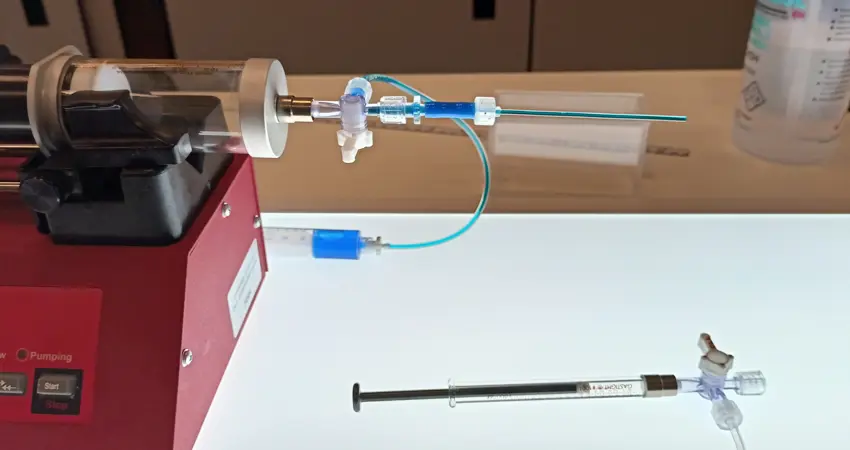21 Nov 2022
New mathematical model could help avoid spattering squeezy sauce bottles
Findings from Dr Callum Cuttle and Professor Chris MacMinn could have important implications for many different fields that involve displacing a fluid with a gas

Most of us are all too familiar with how, when we come to the end of a squeezy sauce bottle, the smooth flow of liquid can suddenly turn to a messy spatter. But a new mathematical model has shed light onto why this phenomenon occurs and what we could do to stop it.
The new findings, from Dr Callum Cuttle and Professor Chris MacMinn, could have important implications for many different fields that involve displacing a fluid with a gas, including storing captured carbon dioxide in aquifers, understanding certain types of volcanic eruption, re-inflating collapsed lungs, and designing better fuel cells.
Dr Cuttle conducted a series of experiments, injecting air from a syringe into an oil-filled capillary tube, to investigate why a smooth flow of liquid can abruptly become a shower. "Our experimental system is simple, but it replicates all of the essential parameters of a more complicated system, such as a squeezy ketchup bottle" he says.
When we squeeze a sauce bottle, the air inside the top of the bottle compresses like a spring, pushing the incompressible liquid out ahead of it. This downward force is resisted by the viscosity (or ‘drag’) of the liquid against the walls of the tube. The balance of these two forces determines the rate at which the liquid flows out.
The experiments and mathematical analysis of Dr Cuttle and Professor MacMinn reveal how these forces change over time. Professor MacMinn explains: "You need to compress the air to generate the driving force to move the liquid. As the liquid flows out, the resistance from viscosity decreases because there is less and less liquid to push. At the same time, the outflow of liquid makes more room for the air to expand into the tube, which decreases the driving force over time."
But what happens when this smooth flow changes to a splatter? Dr Cuttle’s analysis, based on a branch of mathematics known as nonlinear dynamics, reveals that this change happens at a critical threshold, which depends on many factors including the amount of air, the rate of compression, and the diameter of the nozzle.
As the liquid drains away completely, the resistance effectively vanishes. Below the threshold point, the driving force vanishes at exactly the same time and the flow ends smoothly. Above the threshold, the driving force vanishes more slowly than the resistance and the air becomes over-compressed. This force acts like a pent-up spring, causing the last bit of liquid to be expelled in a burst.
"Our analysis reveals that the splattering of a ketchup bottle can come down to the finest of margins: squeezing even slightly too hard will produce a splatter rather than a steady stream of liquid," Dr Cuttle says.
These insights suggest several methods that could theoretically help avoid the spatter. For example, squeezing more slowly would reduce the rate at which the gas is compressed. The most effective change would be to design bottles with broader nozzles to reduce the amount of viscous drag.
But according to Dr Cuttle, one of the major problems with modern bottles is the rubber valve at the spout. "These valves make the spattering problem worse by forcing you to build up a certain amount of pressure before the sauce can even start to escape. These valves help to avoid leaks, but purely from a splattering perspective, removing these valves would make a lot of sense. For a quick remedy, when you get close to the end of a bottle (when a splatter is most likely), just take the cap off and squeeze the remaining liquid out of the broader neck. It's common sense, but now there is a rigorous mathematical framework to back it up."
The study ‘Dynamics of compressible displacement in a capillary tube’ was presented at the American Physical Society's Division of Fluid Dynamics conference on Sunday 20 November. The preprint study can be viewed online.




